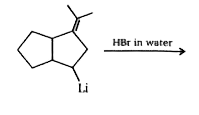Aldehyde, ketone, acid and acid derivatives contain >C=O group. Aldehyde and ketones gives nucleop addition reactions where as acid and acid derivatives gives nucleophilic addition followed by ellmination reaction Nucleophilic addition reactions followed by ellimination of acid derivatives is known as acyl substitution reacts This subsitution reaction takes places by formation of tertrahedral intermediate.
Which of the following compounds has very poor leaving group?
_E01_572_O01.png)
_E01_572_O02.png)
_E01_572_O03.png)
_E01_572_O04.png)
The correct Answer is:A
To determine which of the compounds has a very poor leaving group, we need to analyze the nature of the leaving groups in the given options.
1. Understanding the Reaction Mechanism:
- Aldehydes and ketones undergo nucleophilic addition where a nucleophile attacks the electrophilic carbon of the carbonyl group (C=O).
- In the case of acid derivatives, the reaction involves nucleophilic addition followed by elimination, leading to acyl substitution.
2. Identifying the Leaving Group:
- The leaving group is the part of the molecule that departs during the reaction. The stability of the leaving group after it departs is crucial in determining its effectiveness.
- Generally, a good leaving group is one that can stabilize the negative charge formed after leaving.
3. Evaluating the Options:
- Option A: C=O with H as the leaving group. When H leaves, it forms H⁻, which is highly unstable and thus a very poor leaving group.
- Option B: C=O with Cl as the leaving group. Chlorine (Cl⁻) is a stable ion and a good leaving group.
- Option C: C=O with OH as the leaving group. Hydroxide (OH⁻) can also stabilize the negative charge, making it a decent leaving group.
- Option D: C=O with OR as the leaving group. Alkoxide ions (OR⁻) are also relatively stable and can act as good leaving groups.
4. Conclusion:
- Among the options, the compound with H as the leaving group (Option A) is the one with a very poor leaving group due to the instability of H⁻.
Final Answer:
The compound with a very poor leaving group is Option A (C=O with H as the leaving group).
- Aldehydes and ketones undergo nucleophilic addition where a nucleophile attacks the electrophilic carbon of the carbonyl group (C=O).
- In the case of acid derivatives, the reaction involves nucleophilic addition followed by elimination, leading to acyl substitution.
- The leaving group is the part of the molecule that departs during the reaction. The stability of the leaving group after it departs is crucial in determining its effectiveness.
- Generally, a good leaving group is one that can stabilize the negative charge formed after leaving.
- Option A: C=O with H as the leaving group. When H leaves, it forms H⁻, which is highly unstable and thus a very poor leaving group.
- Option B: C=O with Cl as the leaving group. Chlorine (Cl⁻) is a stable ion and a good leaving group.
- Option C: C=O with OH as the leaving group. Hydroxide (OH⁻) can also stabilize the negative charge, making it a decent leaving group.
- Option D: C=O with OR as the leaving group. Alkoxide ions (OR⁻) are also relatively stable and can act as good leaving groups.
- Among the options, the compound with H as the leaving group (Option A) is the one with a very poor leaving group due to the instability of H⁻.
The compound with a very poor leaving group is Option A (C=O with H as the leaving group).
Topper's Solved these Questions
- ALKENE, ALKANE & ALKYNE Book:ALLENChapter:ALKENE, ALKANE & ALKYNE Exercise:EXERCISE-4(A)
Explore 10 Videos
- ALKENE, ALKANE & ALKYNE Book:ALLENChapter:ALKENE, ALKANE & ALKYNE Exercise:EXERCISE-4(B)
Explore 10 Videos
- ALKENE, ALKANE & ALKYNE Book:ALLENChapter:ALKENE, ALKANE & ALKYNE Exercise:EXERCISE-2
Explore 103 Videos
- AIIMS 2019Book:ALLENChapter:AIIMS 2019Exercise:CHEMISTRY
Explore 40 Videos
- ALKYL AND ARYL HALIDEBook:ALLENChapter:ALKYL AND ARYL HALIDEExercise:EXERCISE-05 (B)
Explore 35 Videos
Similar Questions
Aldehyde, ketone, acid and acid derivatives contain >C=O group. Aldehyde and ketones gives nucleop addition reactions where as acid and acid derivatives gives nucleophilic addition followed by ellmination reaction Nucleophilic addition reactions followed by ellimination of acid derivatives is known as acyl substitution reacts This subsitution reaction takes places by formation of tertrahedral intermediate.
Which one of the following is least reactive compound for nucleophilic acyl substitution.
View SolutionAldehyde, ketone, acid and acid derivatives contain >C=O group. Aldehyde and ketones gives nucleop addition reactions where as acid and acid derivatives gives nucleophilic addition followed by ellmination reaction Nucleophilic addition reactions followed by ellimination of acid derivatives is known as acyl substitution reacts This subsitution reaction takes places by formation of tertrahedral intermediate. For the given reaction
_E01_571_Q01.png)
which of these is correct?
View Solution
Knowledge Check
Which of the following compounds may give reaction with acidic KMnO4 ?
A B
B C
C D
D
Which of the following compounds will give acid base reaction with RMgX?
ACH3−O∣∣C−ClBH2SCH−O∣∣C−O−HD
In Which of the following reaction an acid-base reaction takes place ?
A B
B C
C DAll of these
DAll of these
Why do aldehydes and ketones undergo nucleophilic addition reactions. Give one example.
View SolutionWhich of the following reactions would give caproic acid ?
View SolutionA : Aldehydes and ketones undergo nucleophilic addition reaction.
R : Aldehydes and ketones contain carbonyl group.
View SolutionWhich of the following reaction(s) do/does not give an oxo-acid?
View SolutionWhich carbonyl group is protonated most readily in acidic solution, but gives nucleophilic addition by NH4NH−Ph least readily ?
View Solution